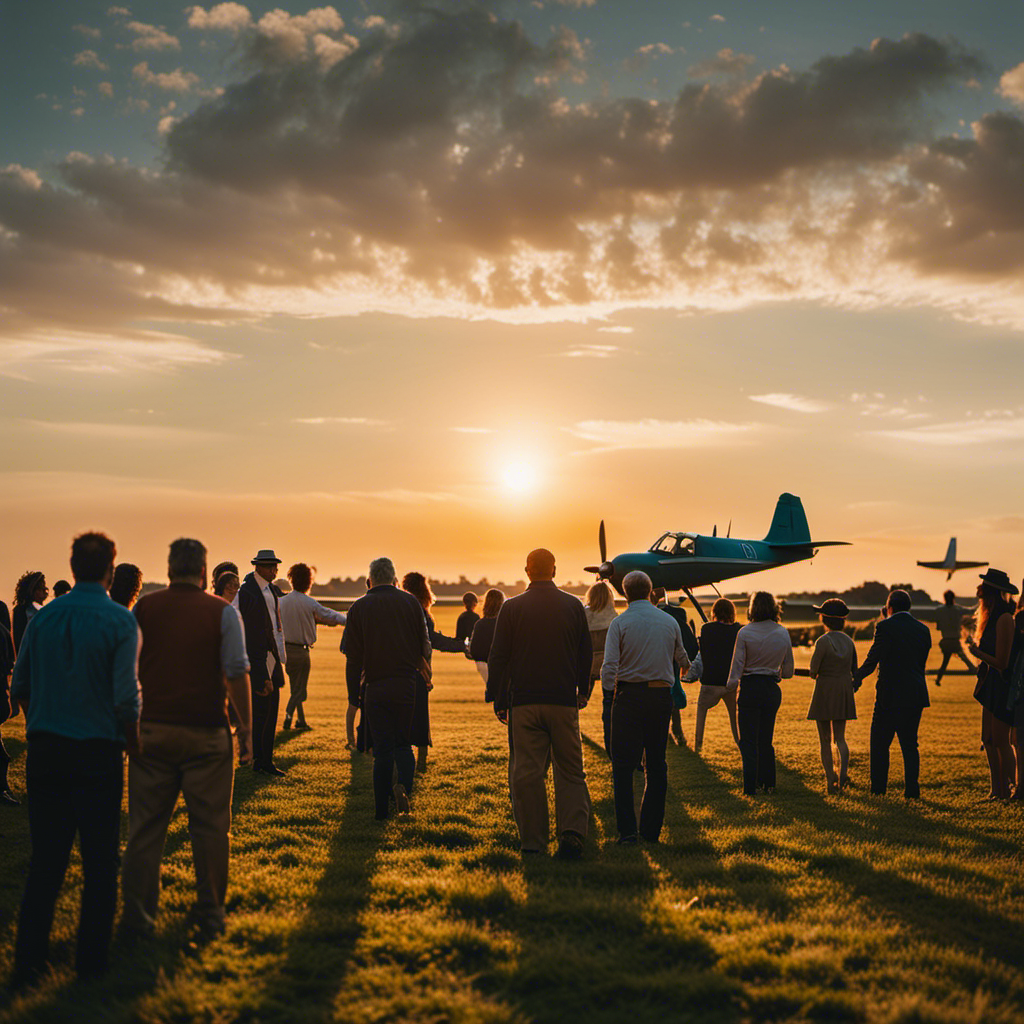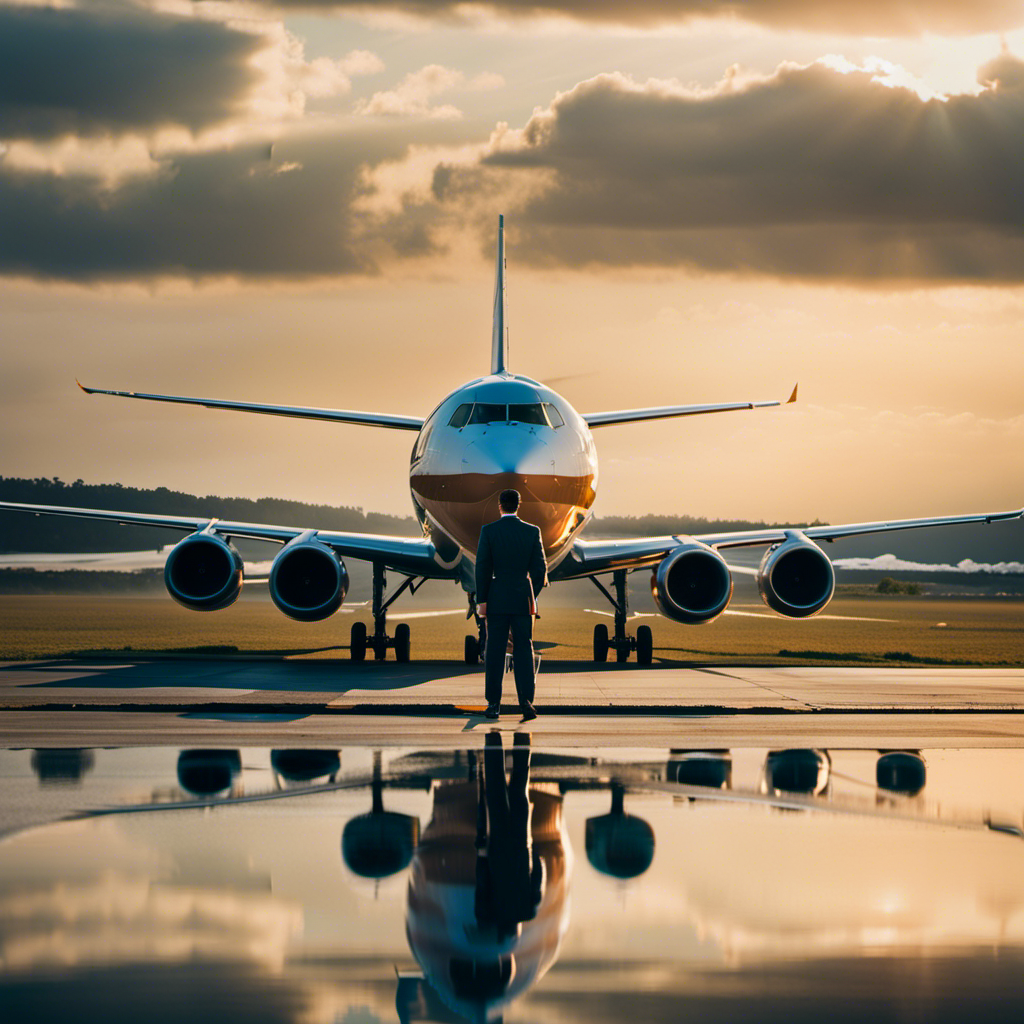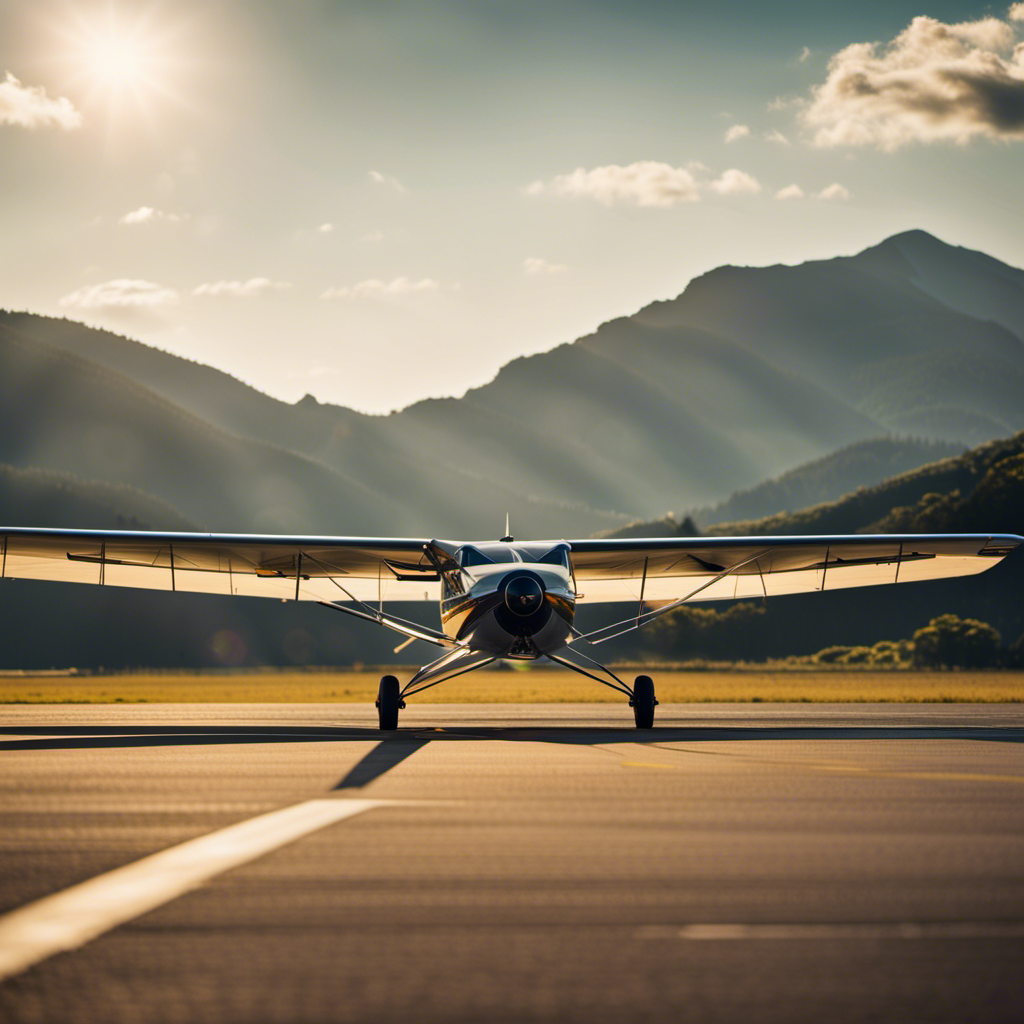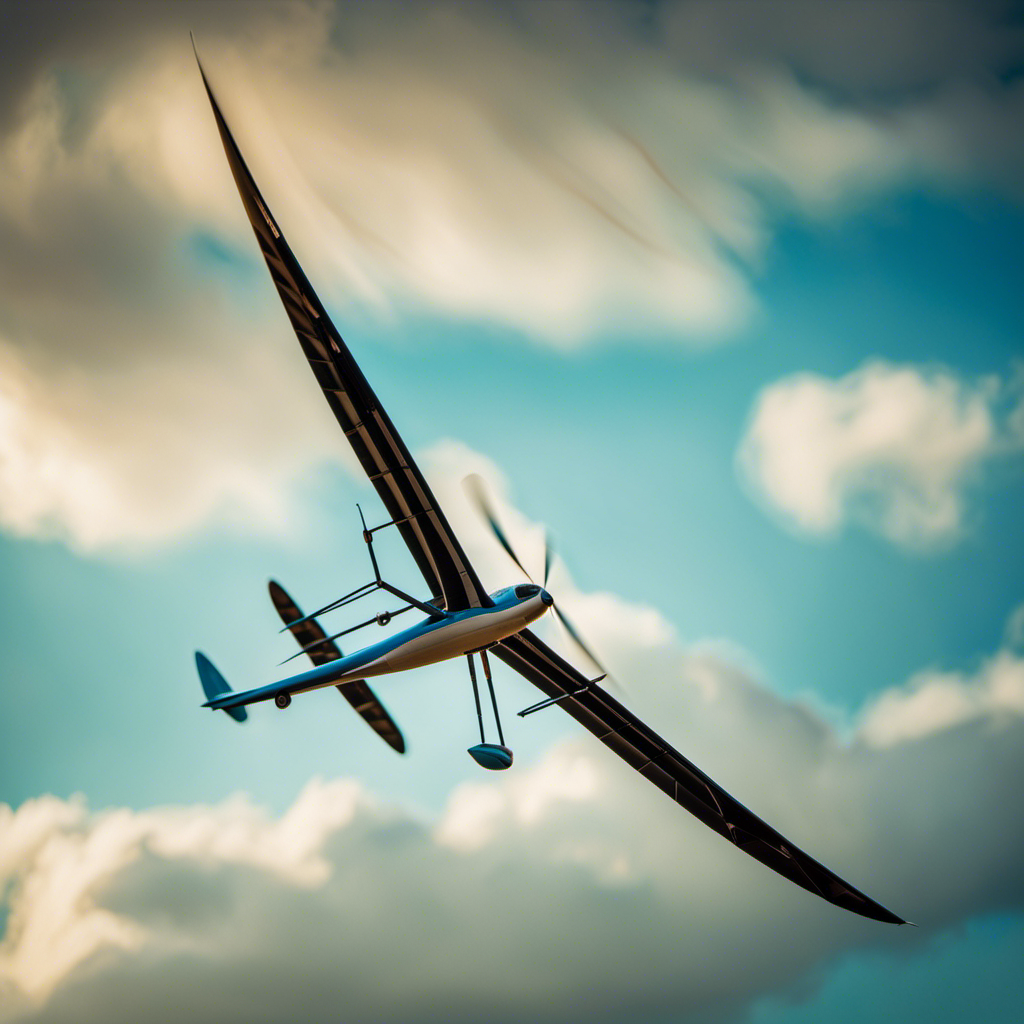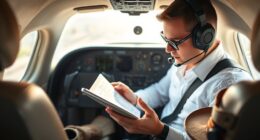I completely agree with the sentiment that there are no limits to what you can achieve, as the saying goes. This article is dedicated to those who have dreamed of soaring through the clouds.
I’ll be your guide as we embark on a journey to learn flying. From understanding the basics to obtaining a pilot’s license, we’ll cover all the necessary steps.
So fasten your seatbelt, because we’re about to take off into the world of aviation!
Key Takeaways
- Pilot training programs cover subjects like aerodynamics, navigation, meteorology, and aircraft systems.
- Understanding the basics of aerodynamics, navigation, and communication is crucial for safe flying.
- Weather conditions have a significant impact on flying, and pilots need to continuously monitor and plan for them.
- When starting the journey to learn flying, it is important to choose the right flight school, meet medical requirements, and gain experience through accumulating flight hours.
Introduction to Aviation
So, you’re ready to learn how to fly, huh? Well, let’s start by introducing you to the exciting world of aviation.
Aviation offers a wide range of career opportunities, and one of the most popular is becoming a pilot. Pilot training programs are designed to equip aspiring aviators with the necessary knowledge and skills to navigate the skies safely.
These programs cover a variety of subjects, including aerodynamics, navigation, meteorology, and aircraft systems. They typically include both ground school instruction and flight training, allowing students to gain a thorough understanding of the principles and techniques involved in piloting an aircraft.
By completing a pilot training program, you’ll be one step closer to realizing your dream of flying.
Now, let’s dive into understanding the basics of aviation without further ado.
Understanding the Basics
When it comes to understanding the basics of aviation, there are three key points to consider: aerodynamics and how planes fly, navigation and communication, and weather conditions and their impact on flying.
Aerodynamics is the fundamental principle behind flight, explaining how air flows around the wings and generates lift.
Navigation and communication are crucial for pilots to safely navigate the skies and communicate with air traffic control.
Lastly, weather conditions play a significant role in aviation, as pilots need to be aware of factors such as wind, turbulence, and visibility to ensure a smooth and safe flight.
Aerodynamics and how planes fly
To understand how planes fly, you’ll need to grasp the principles of aerodynamics. Aerodynamic principles govern the movement of an aircraft through the air, and two key concepts are lift and drag. Here’s a breakdown of these principles:
-
Lift: This upward force is generated by the wings as air flows over and under them. The shape and angle of the wings, along with the speed of the aircraft, determine the amount of lift produced.
-
Drag: This resistance force acts in the opposite direction of motion and is caused by air friction. It can be reduced by streamlining the aircraft and minimizing unnecessary protrusions.
-
Wing design: The shape, size, and angle of the wings play a crucial role in generating lift efficiently.
-
Thrust: This force propels the aircraft forward and is produced by engines or propellers.
-
Weight: The force of gravity acting on the aircraft, which needs to be balanced by lift for steady flight.
Understanding these aerodynamic principles will lay the foundation for comprehending how planes stay airborne and maneuver in the sky.
Now, let’s delve into the next section about navigation and communication.
Navigation and communication
You can enhance your navigation and communication skills to ensure a safe and efficient flight.
GPS technology plays a crucial role in modern aviation, providing accurate position information and aiding in navigation. By familiarizing yourself with GPS systems, you can effectively plan your route and make informed decisions during flight.
Additionally, understanding radio frequencies is essential for effective communication with air traffic control and other pilots. By using the correct frequencies and following proper communication protocols, you can ensure clear and concise interactions, enhancing safety and efficiency.
Now that you have a solid foundation in navigation and communication, it’s important to consider weather conditions and their impact on flying. Weather plays a significant role in aviation, and understanding its effects is essential for a successful flight.
Weather conditions and their impact on flying
Understanding weather conditions and their impact is crucial for safe and efficient flying. As a pilot, I need to be aware of the ever-changing weather patterns and how they can affect my flight. Here are some key points to consider:
-
Impact of turbulence: Turbulence can be caused by varying weather conditions, such as strong winds or thunderstorms. It can significantly affect the stability and comfort of the aircraft, making it essential to avoid turbulent areas whenever possible.
-
Effect of fog: Fog reduces visibility, making it difficult to navigate and land safely. Pilots must rely on instruments and follow specific procedures when flying in foggy conditions to ensure a safe flight.
-
Weather forecasting: Accurate weather forecasts are crucial for flight planning. By analyzing weather charts and forecasts, pilots can anticipate potential hazards and plan alternative routes or adjust their departure times accordingly.
-
Weather monitoring: During the flight, pilots continuously monitor weather conditions using onboard weather radar and communication with air traffic control. This allows them to adapt their flight path if necessary and ensure the safety of the passengers and crew.
-
Emergency weather procedures: In the event of sudden severe weather conditions, pilots are trained in emergency procedures to handle situations like lightning strikes or hailstorms. These procedures help minimize the risks associated with extreme weather events.
Understanding these weather factors and their impact on flying is vital for every pilot. It allows us to make informed decisions and ensures the safety of both the aircraft and its occupants.
Now, let’s explore the next important aspect of starting your journey to learn flying: choosing the right flight school.
Choosing the Right Flight School
When choosing the right flight school, it’s important to consider factors like location, reputation, and cost. Flight school facilities play a crucial role in providing a conducive learning environment. Look for schools that have well-maintained aircraft, simulators, and spacious classrooms for theoretical lessons. Additionally, it’s essential to evaluate the qualifications of the instructors. Experienced instructors with a strong background in aviation will ensure effective training and guidance throughout your journey. To help you make an informed decision, here is a table comparing two flight schools:
| Flight School | Facilities | Instructor Qualifications |
|---|---|---|
| School A | Modern fleet of aircraft, state-of-the-art simulators | Highly experienced instructors with airline backgrounds |
| School B | Limited aircraft options, basic simulators | Instructors with a minimum of 500 flight hours |
Choosing the right flight school is the first step towards obtaining a pilot’s license, which will be discussed further in the next section.
Obtaining a Pilot’s License
When it comes to obtaining a pilot’s license, there are several key points to consider.
First, you must meet the medical requirements set by the aviation authority, ensuring that you are physically fit to fly.
Second, you will need to pass written and practical exams that test your knowledge and skills in areas such as navigation, weather, and aircraft operation.
Lastly, you will need to accumulate the required flight hours and gain valuable experience to demonstrate your competence as a pilot.
Medical requirements
To meet the medical requirements for learning to fly, you’ll need to schedule a visit with an aviation medical examiner. These medical examinations are crucial to ensure that you are physically and mentally fit to operate an aircraft safely.
The examiner will assess your overall health, including vision, hearing, and cardiovascular fitness. They will also evaluate your mental health and any medications you may be taking. Fitness requirements are set by regulatory authorities to ensure the safety of both the pilot and passengers.
Once you have successfully passed the medical examination, you can move on to the next phase of your journey to becoming a pilot: the written and practical exams, where you will showcase your knowledge and skills in aviation theory and flight operations.
Written and practical exams
Once you’ve completed the medical requirements, you’ll need to prepare for the written and practical exams that will test your knowledge and skills in aviation theory and flight operations. These exams are crucial for obtaining your pilot’s license and demonstrating your competence as a pilot.
Here is what you need to know about these exams:
-
Written exams: These exams cover a wide range of topics, including aerodynamics, navigation, meteorology, regulations, and aircraft systems. You will need to study extensively and understand the principles behind these subjects.
-
Practical exams: These exams assess your ability to apply the knowledge you have gained in a real-world flying scenario. You will be evaluated on your flight planning, decision-making, communication skills, and overall flight performance.
-
Preparation is key: To succeed in these exams, you must dedicate time to studying and practicing both in the classroom and in the aircraft. Utilize study materials, practice exams, and seek guidance from experienced instructors.
-
Stay focused and confident: The exams can be challenging, but with thorough preparation and a positive mindset, you can excel and pass with flying colors.
Once you have successfully completed these exams, you can move on to the next phase of your journey, accumulating flight hours and gaining valuable experience in the cockpit.
Flight hours and experience
Gaining flight hours and experience is essential for becoming a skilled pilot. Aspiring aviators can supplement their training by utilizing flight simulators, which provide a realistic experience without the risks associated with actual flight. These simulators allow pilots to practice various maneuvers, emergency procedures, and instrument flying in a controlled environment.
Additionally, aviation internships offer invaluable opportunities to gain hands-on experience in the industry. Interns can assist with pre-flight inspections, learn about aircraft maintenance, and even observe flights from the cockpit. These experiences not only enhance flying skills but also provide a deeper understanding of the aviation industry as a whole.
Transitioning into the next section, learning to fly also involves ground school, where aspiring pilots gain theoretical knowledge and learn about the principles of flight.
Learning to Fly: Ground School
When it comes to learning to fly, there are several key points that need to be understood and mastered.
First, understanding regulations and safety procedures is crucial in order to ensure safe and compliant operation of an aircraft.
Additionally, navigation and flight planning skills are essential in order to effectively navigate through airspace and reach your intended destination.
Finally, having a solid understanding of aircraft systems and controls is necessary to operate the aircraft safely and efficiently.
These three areas are fundamental to becoming a proficient pilot.
Regulations and safety procedures
Before you can take to the skies, it’s important to familiarize yourself with the regulations and safety procedures of flying. As a pilot, regulations compliance and adherence to safety protocols are critical to ensure a safe and efficient flight. Here are some key aspects to consider:
- Understanding airspace classifications and restrictions
- Complying with flight planning and communication protocols
- Adhering to weight and balance limitations
- Conducting regular aircraft inspections and maintenance
- Familiarizing yourself with emergency procedures and evacuation plans
By following these regulations and safety procedures, you can ensure the safety of yourself, your passengers, and others in the airspace.
Now that you are well-versed in the importance of regulations and safety, let’s dive into the next section: navigation and flight planning, where we will explore the intricacies of plotting routes and preparing for a successful flight.
Navigation and flight planning
Now that you’re familiar with regulations and safety procedures, let’s delve into navigation and flight planning to ensure a smooth and successful journey.
Navigation is a critical aspect of flying, and it involves using various flight instruments to determine the aircraft’s position and direction. These instruments include the altimeter, airspeed indicator, and heading indicator. They provide crucial information to the pilot, enabling them to navigate accurately.
Additionally, flight planning involves determining the optimal route, taking into account factors such as weather conditions, airspace restrictions, and fuel consumption. To practice and enhance these skills, pilots often use flight simulators, which provide a realistic virtual environment for training.
By incorporating flight instruments and flight simulators into your learning process, you will develop the necessary skills to navigate and plan flights effectively.
Moving on to the next section, let’s explore aircraft systems and controls.
Aircraft systems and controls
To understand how the aircraft systems and controls work, you’ll need to familiarize yourself with the various components and their functions.
Aircraft maintenance is crucial in ensuring the proper functioning of these systems. Regular inspections and repairs are necessary to prevent any malfunctions during flight.
Emergency procedures are also an essential part of aircraft maintenance. Pilots must be well-trained in handling emergency situations, such as engine failures or electrical system malfunctions. Understanding the aircraft systems and controls is vital in effectively responding to these emergencies.
Learning about these systems and controls is just the beginning of your journey to become a pilot. It lays the foundation for the next step in your training: flight training, where you will put your knowledge into practice and learn how to operate an aircraft.
Learning to Fly: Flight Training
Flight training is an exciting and challenging process that will teach you the skills needed to become a pilot. One of the key tools used in flight training is the flight simulator. These advanced simulators provide a realistic environment where you can practice various flight scenarios without leaving the ground. They allow you to develop your skills in a safe and controlled setting, preparing you for the real thing.
In addition to the simulators, flight instructors play a crucial role in your training. They are experienced pilots who will guide you through each step of the learning process, providing valuable insights and feedback. Their expertise and guidance will help you become a confident and competent pilot.
As you progress through your flight training, you will gradually build experience and confidence, preparing you for the challenges and responsibilities of piloting an aircraft.
Building Experience and Confidence
Building experience and confidence as a pilot is crucial for successfully navigating the challenges and responsibilities of flying an aircraft. Here are three key ways to build experience and gain confidence in your flying journey:
-
Flight Hours: The more you fly, the more comfortable and skilled you become. Logging hours in different weather conditions, airports, and aircraft types will broaden your experience and improve your abilities.
-
Simulator Training: Utilizing flight simulators can provide a cost-effective way to practice various scenarios, such as emergency procedures or instrument flying, in a controlled environment. This helps build muscle memory and enhances decision-making skills.
-
Mentoring: Seek guidance from experienced pilots who can share their knowledge and offer valuable insights. Learning from their experiences can accelerate your learning process and help you avoid common mistakes.
Additional Ratings and Certifications
After gaining experience and confidence in my flying abilities, I was ready to explore additional ratings and certifications to further enhance my skills in the aviation field. These additional credentials would not only demonstrate my proficiency but also open up new opportunities for me in the industry.
I began by pursuing advanced training programs that offered specialized endorsements, such as instrument flying, multi-engine aircraft, and aerobatics. These endorsements provided me with a deeper understanding of complex flight systems, improved my decision-making skills, and expanded my overall knowledge base.
Alongside these endorsements, I also pursued additional ratings and certifications, such as becoming a certified flight instructor or obtaining a commercial pilot license. These achievements not only showcased my dedication to aviation but also made me a more well-rounded and marketable pilot.
As I continued to accumulate these credentials, I was eagerly preparing myself to join the aviation community and embark on a fulfilling career in flying.
Joining the Aviation Community
Once you’ve obtained your certifications and ratings, joining the aviation community allows you to connect with like-minded individuals who share your passion for flying. It provides a platform to expand your knowledge, engage in meaningful discussions, and stay updated with the latest developments in the field. Here are some benefits of joining the aviation community:
-
Aviation Events: Attending aviation events gives you the opportunity to immerse yourself in the industry. From airshows to conferences, these events offer a firsthand experience of new technologies, aircraft, and industry trends.
-
Networking Opportunities: The aviation community is filled with professionals from various backgrounds. Networking allows you to build valuable connections, exchange ideas, and potentially find mentors or job opportunities.
-
Knowledge Sharing: Being part of the aviation community means being part of a wealth of knowledge. Engaging with other pilots, aviation enthusiasts, and industry experts enables you to learn from their experiences and gain insights that can enhance your own flying skills.
-
Support and Encouragement: The aviation community is known for its camaraderie and support. Whether you’re facing challenges in your training or simply want to share your achievements, being part of this community means having a network of individuals who understand and can provide guidance.
Joining the aviation community opens doors to countless opportunities for growth and learning. It sets the foundation for continuing education and career opportunities in the field of aviation.
Continuing Education and Career Opportunities
Being part of the aviation community opens up a world of opportunities for further education and career advancement. In the field of aviation, continuing education is essential to stay up-to-date with the latest advancements in technology, regulations, and best practices.
As an aviation professional, I have found that pursuing continuing education not only enhances my knowledge and skills but also opens doors to new career opportunities. Whether it is obtaining advanced certifications or attending workshops and conferences, continuing education allows me to stay competitive in the ever-evolving aviation industry.
It not only helps me expand my expertise but also provides a platform to network with industry leaders and experts. By investing in my own professional development, I am able to unlock a multitude of career advancement opportunities within the aviation field.
Frequently Asked Questions
How long does it take to obtain a pilot’s license?
Obtaining a pilot’s license depends on various factors such as the type of license and the individual’s dedication. On average, it takes around 6-12 months of flight training to obtain a pilot’s license.
What are the physical requirements to become a pilot?
To become a pilot, one must meet the physical requirements. Pilot medical exams ensure fitness for flying, assessing vision, hearing, and overall health. These exams are crucial as they prioritize safety in the sky.
How much does flight training cost?
Flight training costs can vary greatly depending on factors such as location and type of training. A cost breakdown typically includes expenses for flight hours, ground instruction, exams, and materials. Financing options, such as loans or scholarships, are available to help aspiring pilots cover the costs.
Are there any age restrictions to become a pilot?
Yes, there are age restrictions to become a pilot. The minimum age for a private pilot license is 17, while for a commercial pilot license it is 18. Training requirements include flight hours and passing written and practical exams.
Can I learn to fly if I have a fear of heights?
I can learn to fly even if I have a fear of heights. Overcoming fears and building confidence is a crucial part of flight training. With the right support and training, I can overcome my fear and become a pilot.
Conclusion
In conclusion, learning to fly is an exciting and rewarding journey that anyone can embark on. While it may seem daunting at first, with the right flight school and dedication, obtaining a pilot’s license is within reach.
Contrary to popular belief, age is not a barrier to pursuing a career in aviation. So, if you’ve ever dreamt of soaring through the skies, don’t let anything hold you back. Take that leap of faith and begin your journey to the world of aviation today.
With a heart that soars as high as the skies, Aria, affectionately known as “Skylark,” is the driving force behind Soaring Skyways. Her journey into the gliding world began as a young dreamer gazing up at the soaring birds, yearning to experience the weightlessness and freedom they embodied. With years of experience both in the cockpit and behind the scenes, Aria’s commitment to the gliding community is unwavering.
